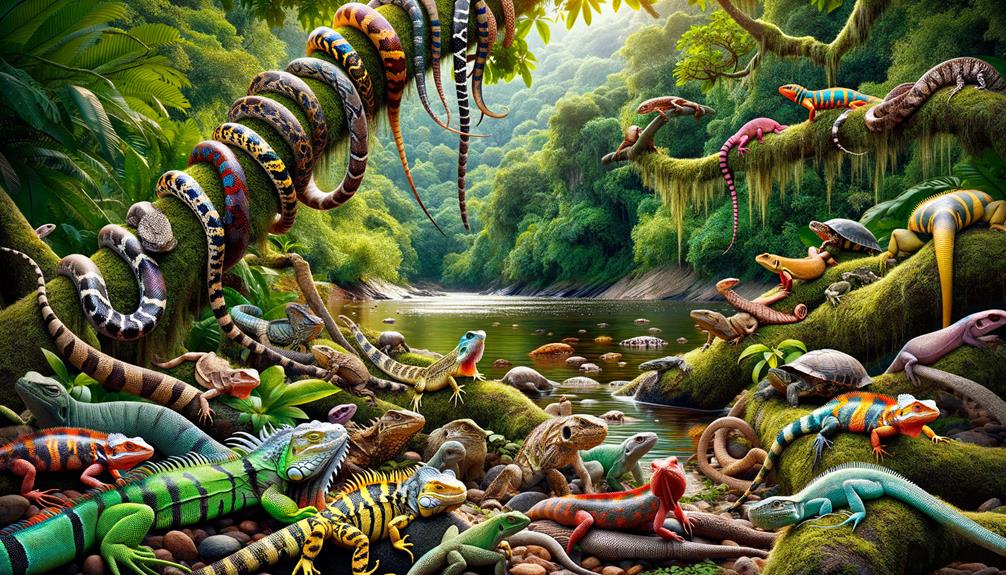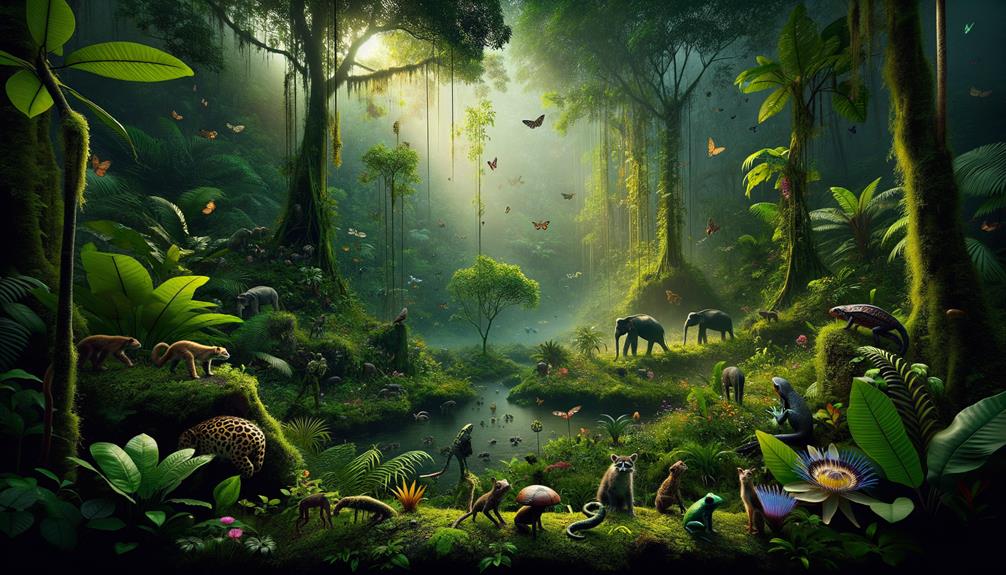I recently stumbled upon the fascinating discovery of the Bolitoglossa bolanosi salamander in Costa Rica’s Talamanca Mountain Range. This tiny creature, measuring just 1.6-2 inches long, has broad hands and feet perfectly suited for navigating its mossy, uneven habitat. Its smooth skin, ranging in color from brownish-black to violet, and the lighter patches on its head create a striking appearance. Found at elevations between 8,370 and 10,630 feet, this salamander thrives in La Amistad International Park’s unique ‘sky island’ ecosystem. This discovery highlights the rich, yet fragile, biodiversity of Costa Rica, and there’s still much to uncover about these remarkable creatures.
Key Takeaways
A newly discovered species of salamander, Bolitoglossa bolanosi, has been found in Costa Rica’s Talamanca Mountain Range. This species inhabits the high-altitude regions of La Amistad International Park, specifically between 8,370 and 10,630 feet above sea level. The salamander’s habitat consists of moss-covered grounds and spongy soil in subalpine rain páramo. Characterized by its broad hands, smooth skin, and distinctive coloration, Bolitoglossa bolanosi is a unique addition to Costa Rica’s herpetofauna. The discovery of this species highlights the importance of conserving Costa Rica’s cloud forests and páramo ecosystems.
Discovery in Talamanca Mountains
While exploring the Talamanca Mountain Range, our team stumbled upon a remarkable new species of salamander, Bolitoglossa bolanosi. As part of the expedition in Costa Rica, the thrill of uncovering a previously unknown species was exhilarating. We found Bolitoglossa bolanosi at elevations between 8,370-10,630 feet within the pristine confines of La Amistad International Park. This region’s isolation and unique climatic conditions likely contributed to the salamander’s distinctiveness.
The Talamanca Mountains, with their steep slopes and dense cloud forests, are a hotbed of biodiversity. Our team navigated through the thick underbrush and slippery trails to reach the specific altitudinal range where this new species resides. The discovery of Bolitoglossa bolanosi adds to the ecological richness of Costa Rica, a country already renowned for its incredible variety of life forms.
Named in honor of esteemed Costa Rican herpetologist Federico Bolanos, Bolitoglossa bolanosi is now the fourth known salamander species exclusive to the subalpine rain páramo region in Isthmian Central America. This discovery highlights the importance of preserving these high-altitude habitats, as they harbor species found nowhere else on Earth.
Characteristics of Bolitoglossa Bolanosi
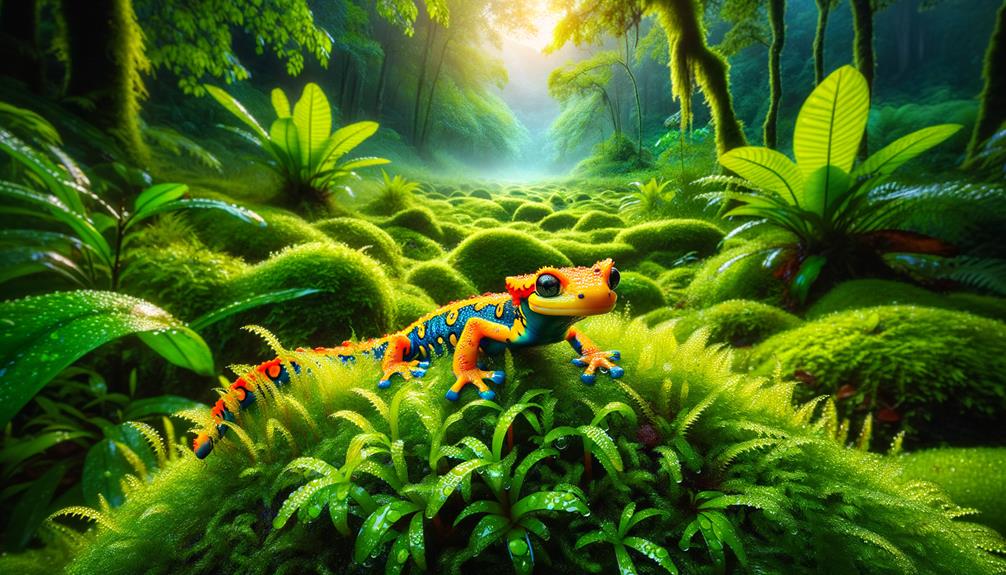
I marveled at the Bolitoglossa bolanosi’s broad hands and feet, perfectly adapted for navigating the mossy terrain of the subalpine páramo. Its smooth, brownish-black skin, often marked with lighter patches, provided a striking contrast to the vibrant greenery of its highland habitat. Observing the females guarding their eggs beneath the moss highlighted this species’ fascinating reproductive behavior.
Distinctive Physical Traits
Nestled within the mossy high-elevation habitats of Costa Rica’s Talamanca Mountain Range, the Bolitoglossa bolanosi salamander has evolved distinctive physical traits that help it thrive in its unique environment.
This amphibian’s broad hands and feet are perfectly adapted for gripping the moist, uneven surfaces of its habitat, providing both stability and agility. Its elongated and slender body, measuring 1.6-2 inches in length, allows it to navigate through narrow crevices and dense vegetation with ease.
Three key physical traits define the Bolitoglossa bolanosi:
- Coloration: Its smooth skin ranges from brownish black to brownish violet, with lighter patches prominently displayed on the head.
- The salamander’s long, slender arms and moderately long legs give it a graceful appearance while enhancing its mobility in the high-elevation terrain.
- Tail: The extended tail not only helps with balance but also serves as a distinguishing feature of this remarkable species.
These traits not only define the Bolitoglossa bolanosi’s appearance but also highlight its remarkable adaptation to the unique environment of Costa Rica.
Habitat and Distribution
Found in the unique subalpine rain páramo of Costa Rica’s Talamanca Mountain Range, the Bolitoglossa bolanosi salamander thrives in elevations between 8,370 and 10,630 feet within La Amistad International Park. This isolated ecosystem, often referred to as a ‘sky island,’ provides a sanctuary with its moss-covered grounds, spongy soil, ferns, and small trees. The páramo’s distinctive environment is a haven for this newly discovered species, which finds refuge among the damp, cool conditions that prevail at such high altitudes.
As I ventured into the páramo, I was struck by the delicate balance of life sustained in this remote habitat. The Bolitoglossa bolanosi, named in honor of Costa Rican herpetologist Federico Bolaños, highlights the richness of Costa Rica’s biodiversity. However, the páramo’s vulnerability makes conservation efforts crucial. It’s not just about protecting the salamander but preserving an entire ecosystem that supports countless other species.
The isolated highlands of the Talamanca Range, with their unique environmental conditions, remind me of the urgent need for conservation. By safeguarding these ‘sky islands,’ we ensure the survival of the Bolitoglossa bolanosi and the intricate web of life it represents.
Behavioral Patterns
Among the fascinating behavioral patterns observed in Bolitoglossa bolanosi salamanders is their remarkable parental care. These amphibians guard their eggs beneath moss on mountain summits, showcasing a remarkable dedication to their progeny. The eggs, nestled within dense moss mats, remain protected from predators and environmental fluctuations, resulting in a higher survival rate.
Several intriguing aspects of their behavior stand out:
- Egg Guarding: Female salamanders vigilantly watch over their eggs, lying in moss mats that provide camouflage and moisture.
- Nocturnal Activity: These salamanders are mostly active at night, emerging to hunt and leveraging their robust bodies and broad limbs.
- Morphological Adaptations: Their smooth, blotchy skin helps them blend into the mossy terrain, reducing the risk of predation.
The Bolitoglossa bolanosi’s skin, typically brownish black to brownish violet with lighter patches, aids in this camouflage. Juveniles, often entirely black, also benefit from this concealment. Their moderately long limbs and long tails enable agile movement through their mountainous habitat. These behavioral patterns highlight the adaptability and resilience of these amphibians, thriving in their unique ecosystem. Observing them reveals a delicate balance of survival and care, showcasing the intricate design of nature.
Habitat and Ecosystem
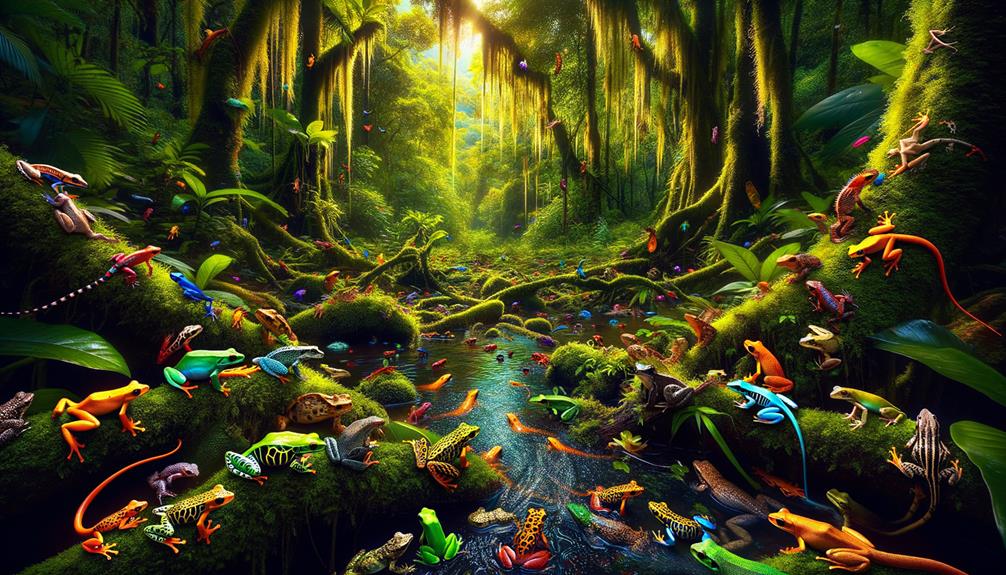
The newly discovered Bolitoglossa bolanosi species thrives in Costa Rica’s Talamanca Mountain Range, a unique subalpine páramo ecosystem. This isolated ‘sky island‘ is characterized by mosses, spongy soils, ferns, and small trees, creating a delicate yet vibrant microcosm where each species plays a vital role in maintaining ecological balance. At elevations between 8,370-10,630 feet, this habitat supports a diverse range of herpetofauna.
As I walk through the páramo, I’m struck by the vast expanses of moss that blanket the ground, interspersed with resilient ferns and stunted, hardy trees. The spongy soil underfoot gives way slightly with each step, a testament to the area’s remarkable water retention properties. This ecosystem is not only visually stunning but also a treasure trove of biodiversity.
Costa Rica’s cloud forests, which cradle the páramo, are home to a rich array of amphibian and reptile species. The discovery of Bolitoglossa bolanosi highlights the hidden biodiversity within these highlands, serving as a poignant reminder of the urgent need for conservation efforts to protect such vulnerable and isolated ecosystems from environmental changes.
Importance of the Discovery

Discovering the Bolitoglossa bolanosi salamander highlights the pressing need to conserve Costa Rica’s cloud forests and páramo ecosystems. This finding underscores the remarkable biodiversity that remains undocumented, emphasizing the urgent requirement to intensify our conservation efforts. The discovery not only expands our scientific knowledge but also stresses the critical significance of preserving these fragile habitats.
Biodiversity Conservation Efforts
Revealing a new species like Bolitoglossa bolanosi highlights the urgent need to protect Costa Rica’s cloud forests and their intricate ecosystems. As a Costa Rican herpetologist, I understand the immense value of identifying hidden biodiversity. This discovery underscores the fragility of the páramo ecosystem and its rapid disappearance.
Costa Rica’s reputation for biodiversity is unparalleled, especially when it comes to the reptiles of Costa Rica. The new salamander species adds a critical piece to our understanding of the nation’s herpetofauna. We must take immediate and robust action to conserve these ecosystems.
Three key reasons drive this urgency:
Firstly, Bolitoglossa bolanosi is found only in the páramo, a unique habitat that’s increasingly threatened by deforestation and habitat loss. Protecting this species means preserving its rare environment.
Secondly, the discovery highlights the importance of further exploration. Documenting hidden biodiversity helps us understand and mitigate amphibian declines.
Thirdly, the health of the cloud forests, which house countless species, including this new salamander, is a barometer for the overall well-being of our planet.
Scientific Research Benefits
The discovery of Bolitoglossa bolanosi, a new species of salamander in Costa Rica’s Talamanca Mountain Range, highlights the country’s incredible herpetofaunal diversity. This finding underscores the importance of continued scientific exploration and the need to protect the region’s unique ecosystems.
Costa Rica is home to over 170 amphibian species and 130 reptile species, making it a hotspot for herpetofaunal diversity. The discovery of Bolitoglossa bolanosi, an endemic species, enriches our understanding of the region’s biodiversity and emphasizes the critical role these species play in their ecosystems.
Detailed observations of this new salamander can provide valuable insights into the evolutionary processes and ecological dynamics that shape the region’s biodiversity. Furthermore, this discovery highlights the vulnerability of the páramo ecosystem, a critically endangered habitat. As deforestation and habitat loss accelerate, the urgency to protect these remaining habitats grows.
Each new species found, like Bolitoglossa bolanosi, serves as a poignant reminder of the richness we stand to lose. Continued research is essential, not just for cataloging species, but also for preserving the delicate balance of life that defines Costa Rica’s natural heritage.
Conservation Efforts
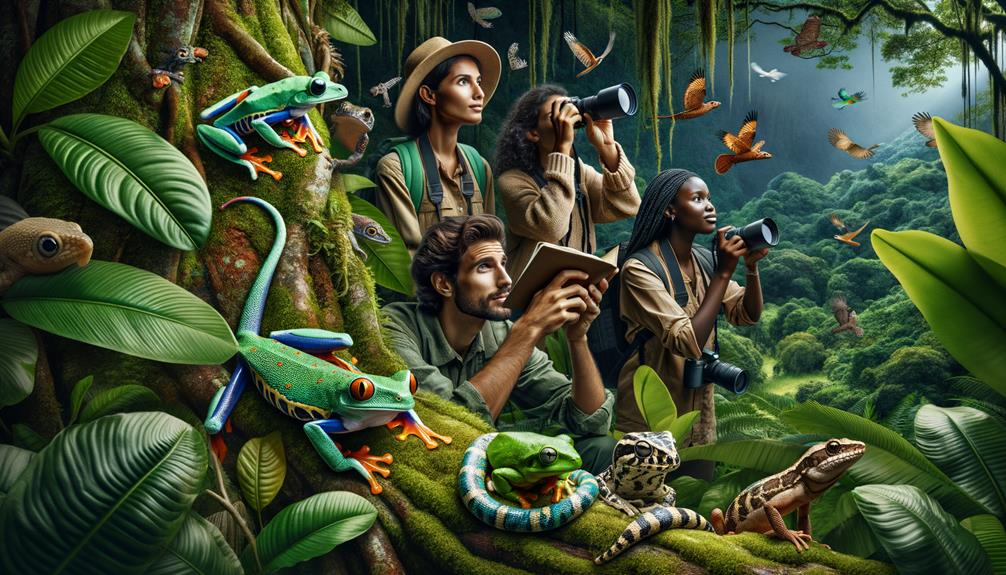
Protecting the critically endangered páramo ecosystem in Costa Rica is vital for preserving unique species like the Bolitoglossa bolanosi salamander, which face threats from deforestation and development. The International Union for Conservation (IUCN) stresses the need to conserve reptiles in these fragile habitats, where many species are found exclusively.
To achieve effective conservation, several key steps are necessary:
- Safeguard National Parks and Reserves: Preserving areas like the Tapir Valley Nature Reserve ensures the protection of endemic species and their habitats.
- Local Community Involvement: Community-based initiatives play a vital role in monitoring and protecting herpetofauna, fostering local stewardship of natural resources.
- Conducting Comprehensive Research: Field guides and scientific publications provide valuable data for conservation strategies, helping to track and understand species populations.
Costa Rica’s biodiversity is remarkable, with over 16% of its amphibian and reptile species being endemic. Preserving these species is crucial not only for the wildlife but also for maintaining the ecological balance and natural beauty of the region. By adopting these conservation efforts, we can ensure that future generations can experience the wonders of Costa Rica’s herpetofauna in their natural habitats.
Future Research Directions
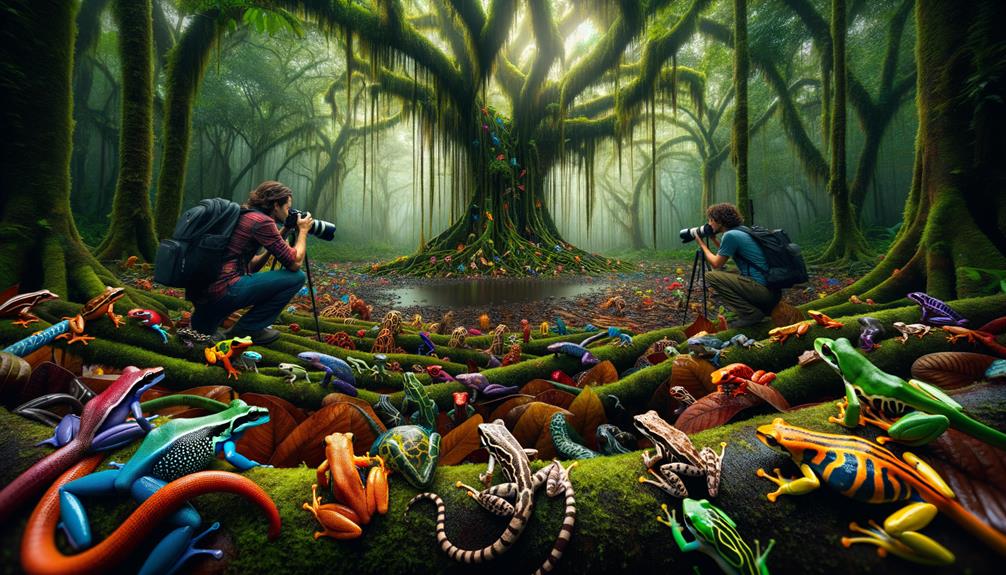
Focusing on future research directions, studying the genetic diversity of Costa Rica’s herpetofauna is crucial for understanding their adaptability to changing environments. By examining the genetic composition of these species, we can uncover how they have evolved to thrive in the diverse ecosystems of this Central American country. This knowledge is vital for predicting their resilience to climate change and habitat loss.
I recall a conversation with Federico Bolaños, a leading herpetologist in Costa Rica, who stressed the significance of molecular studies. He noted that genetic research could reveal cryptic species—those that are morphologically identical but genetically distinct. These hidden species might hold the key to understanding the full scope of Costa Rica’s herpetofauna.
Moreover, we should investigate the ecological roles of these reptiles and amphibians. Their interactions with other species and their contributions to ecosystem functions like pest control and nutrient cycling are areas ripe for exploration. Detailed field studies, combined with advanced laboratory techniques, will provide a comprehensive picture of their ecological significance.
In essence, the future of herpetofaunal research in Costa Rica depends on a multidisciplinary approach that combines genetics, ecology, and conservation science. This integrated strategy will ensure we safeguard these incredible creatures for generations to come.
Frequently Asked Questions
What Is the New Frog Discovered in Costa Rica?
I stumbled upon the Tapir Valley Tree Frog, a tiny green amphibian, while exploring Costa Rica’s Tapir Valley Nature Reserve. Its unusual call caught my attention, leading me to discover this critically endangered species, distinct from Boana rufitela, thriving in a single wetland.
When Was Costa Rica First Discovered?
Costa Rica’s discovery dates back to the early 16th century when the Spanish arrived on the scene. Christopher Columbus landed on the Caribbean coast in 1502, marking the beginning of an era that would unveil the country’s rich natural wonders.
Who Was the First Person to Discover Costa Rica?
Christopher Columbus was the first European to set foot in Costa Rica in 1502, arriving on the Caribbean coast. He was drawn to the area’s lush landscapes and abundant resources, which led him to name it ‘Rich Coast’ due to its wealth of gold and natural riches.
What Has Been Invented in Costa Rica?
I found that Costa Rica pioneered the concept of eco-lodges, which have become a hallmark of sustainable tourism. By blending conservation with exploration, these innovative retreats allow travelers to immerse themselves in nature while preserving its beauty for future generations.


